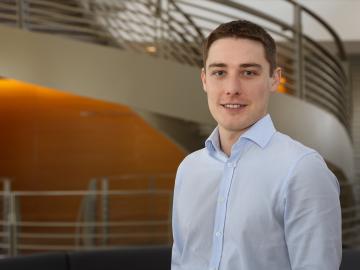
Filter News
Area of Research
- (-) Materials (96)
- (-) Supercomputing (35)
- Advanced Manufacturing (4)
- Biology and Environment (35)
- Computational Biology (1)
- Computer Science (1)
- Electricity and Smart Grid (1)
- Energy Science (86)
- Functional Materials for Energy (2)
- Fusion and Fission (9)
- Materials for Computing (12)
- National Security (7)
- Neutron Science (101)
- Nuclear Science and Technology (5)
- Quantum information Science (2)
News Type
News Topics
- (-) Energy Storage (28)
- (-) Microscopy (21)
- (-) Neutron Science (37)
- (-) Physics (30)
- (-) Polymers (10)
- 3-D Printing/Advanced Manufacturing (20)
- Advanced Reactors (3)
- Artificial Intelligence (38)
- Big Data (18)
- Bioenergy (17)
- Biology (13)
- Biomedical (16)
- Biotechnology (2)
- Buildings (7)
- Chemical Sciences (28)
- Clean Water (2)
- Composites (5)
- Computer Science (82)
- Coronavirus (14)
- Critical Materials (8)
- Cybersecurity (8)
- Environment (30)
- Exascale Computing (25)
- Frontier (31)
- Fusion (4)
- Grid (9)
- High-Performance Computing (42)
- Irradiation (1)
- Isotopes (12)
- ITER (1)
- Machine Learning (14)
- Materials (66)
- Materials Science (59)
- Mathematics (2)
- Molten Salt (2)
- Nanotechnology (32)
- National Security (8)
- Nuclear Energy (15)
- Partnerships (11)
- Quantum Computing (17)
- Quantum Science (29)
- Security (7)
- Simulation (15)
- Software (1)
- Space Exploration (3)
- Summit (37)
- Transportation (12)
Media Contacts

Researchers at ORNL are teaching microscopes to drive discoveries with an intuitive algorithm, developed at the lab’s Center for Nanophase Materials Sciences, that could guide breakthroughs in new materials for energy technologies, sensing and computing.

ORNL researchers used the nation’s fastest supercomputer to map the molecular vibrations of an important but little-studied uranium compound produced during the nuclear fuel cycle for results that could lead to a cleaner, safer world.

Miaofang Chi, a scientist at ORNL, has been elected a Fellow of the Microscopy Society of America.

A study led by researchers at ORNL used the nation’s fastest supercomputer to close in on the answer to a central question of modern physics that could help conduct development of the next generation of energy technologies.

ORNL, TVA and TNECD were recognized by the Federal Laboratory Consortium for their impactful partnership that resulted in a record $2.3 billion investment by Ultium Cells, a General Motors and LG Energy Solution joint venture, to build a battery cell manufacturing plant in Spring Hill, Tennessee.

A world-leading researcher in solid electrolytes and sophisticated electron microscopy methods received Oak Ridge National Laboratory’s top science honor today for her work in developing new materials for batteries. The announcement was made during a livestreamed Director’s Awards event hosted by ORNL Director Thomas Zacharia.

Ten scientists from the Department of Energy’s Oak Ridge National Laboratory are among the world’s most highly cited researchers, according to a bibliometric analysis conducted by the scientific publication analytics firm Clarivate.

A team led by the U.S. Department of Energy’s Oak Ridge National Laboratory demonstrated the viability of a “quantum entanglement witness” capable of proving the presence of entanglement between magnetic particles, or spins, in a quantum material.

ORNL's Larry Baylor and Andrew Lupini have been elected fellows of the American Physical Society.

Matthew Ryder has been named an emerging investigator by the American Chemical Society journal Crystal Growth and Design. The ACS recognized him as “one of an emerging generation of research group leaders for his work on porous materials design.”


